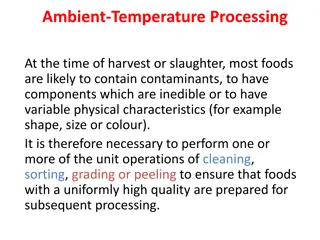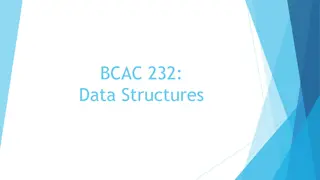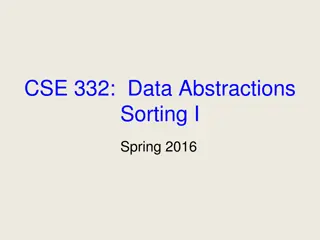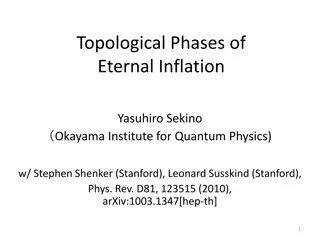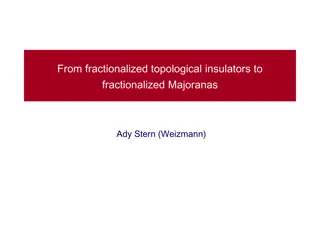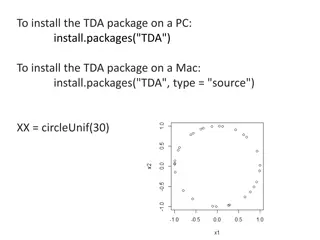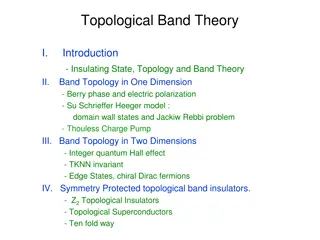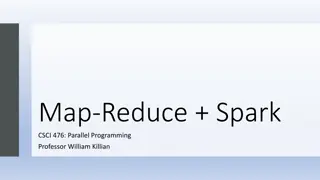Understanding Topological Sorting in Spark GraphX
Explore the essential concepts of Topological Sorting in Spark GraphX, including necessary background knowledge, stand-alone versus distributed implementations, and practical examples. Delve into Spark GraphX's capabilities, such as RDD manipulation, high-level tools, and graph parallel computation. Discover how to partition graphs, compute subgraphs in a distributed manner, and contribute to the Spark community by learning at a base level.
Download Presentation

Please find below an Image/Link to download the presentation.
The content on the website is provided AS IS for your information and personal use only. It may not be sold, licensed, or shared on other websites without obtaining consent from the author. Download presentation by click this link. If you encounter any issues during the download, it is possible that the publisher has removed the file from their server.
E N D
Presentation Transcript
Topo Sort on Spark GraphX Lecturer: 5120309391
Outline Necessary background knowledge on Spark GraphX Topo sort on stand-alone and Spark GraphX Distributed topo sort Lecturer: 5120309391
Spark GraphX Spark A fast engine for server cluster to process large- scale data. Server cluster in prof. Wang s group
Spark GraphX A simple example to understand Spark Word count result1 text1 computing node1 large result large text result2 computing node2 text2 result3 text3 computing node3
Spark GraphX A simple example to understand Spark Word count
Spark GraphX RDD (Resilient Distributed Dataset) Dataset is partitioned into subsets Subsets can be sent to any computing node to process Data can be cached in memory to reuse We can easily put data into RDD!
Spark GraphX Spark high-level tools: Streaming, Mllib, SQL, GraphX Spark Spark Spark Spark SQL Streaming MLlib GraphX Spark RDD
Spark GraphX Spark GraphX A component for graphs and graph- parallel computation A new graph abstraction(extends the Spark RDD) A set of basic graph operations and optimized pregelAPI A growing collection of graph algorithms
Spark GraphX Spark GraphX Partition the graph into several subgraphs Compute the subgraph in a distributed way
Topo sort (topological)
Topo sort Motivation Build a set of graph algorithm such as topo sort on Spark GraphX Research the graph algorithm in a distributed way Try to be a contributor to Spark community Learn Spark Graphx on a base level
Topo sort What is topo sort? A DAG (directed acyclic graph) Maths 2 We can get the topo order as the cource schedule: 2, 5, 3, 7 Data Structure Program Design 3 5 Data Base 7
Topo sort The realization on stand-alone Kahn algorithm
Topo sort The realization on stand-alone 1. Compute the indegrees of every vertex Maths 2 Data Structure Program Design 3 5 Data Base 7
Topo sort The realization on stand-alone 1. Compute the indegrees of every vertex Maths 0 2 Data Structure 1 Program Design 1 3 5 Data Base 7 2 indegree of vertex.
Topo sort The realization on stand-alone Adjacent matrix(graph) Vertex1 Vertex2 VertexN Vertex1 0/1 0/1 Vertex2 0/1 VertexN 0/1 0/1 0/1 0/1 0/1 0/1 Add to get the indegree of vertex1 Edge from VertexN to Vertex2
Topo sort The realization on stand-alone 2. Output the vertex1 of 0 indegree, and minus the indegree of following vertices Maths 0 2 Data Structure 1 Program Design 1 3 5 Data Base 7 2 indegree of vertex.
Topo sort The realization on stand-alone 2. Output the vertex1 of 0 indegree, and minus the indegree of following vertices Output the vertex1 Maths 0 2 Data Structure 1 Program Design 1 3 5 Data Base 7 2 indegree of vertex.
Topo sort The realization on stand-alone 2. Output the vertex1 of 0 indegree, and minus the indegree of following vertices Output the vertex1 Maths Data Structure 1 Program Design 1 0 1 2 -1 3 5 Data Base 7 2 indegree of vertex.
Topo sort The realization on stand-alone 2. Output the vertex1 of 0 indegree, and minus the indegree of following vertices Output the vertex1 Maths Data Structure 1 Program Design 1-1=0 0 1 2 3 5 Data Base 7 2 indegree of vertex.
Topo sort The realization on stand-alone 3. Repeat the step2 Output the vertex1 Maths Data Structure 1 Program Design 0 0 1 2 3 5 Data Base 7 2
Topo sort The realization on stand-alone 3. Repeat the step2 Maths Data Structure 1 Program Design 0 0 1 2 -1 3 5 -1 Output the vertex2 Data Base 7 2
Topo sort The realization on stand-alone 3. Repeat the step2 Maths 1 0 2 Program Design Data Structure 0 5 0 2 3 Data Base 7 1
Topo sort The realization on stand-alone 3. Repeat the step2 Maths 0 1 2 Program Design Data Structure 0 5 2 0 3 -1 Output the vertex3 Data Base 7 1
Topo sort The realization on stand-alone 3. Repeat the step2 Maths 1 0 2 Program Design 5 0 2 Data Structure Data Base 7 0 4 3 3 0
Topo sort The realization on stand-alone Program: Use adjacent matrix to reserve the graph Use array to reserve the vertices and indegrees Use for-loop to find the 0 indegree vertex Maths Use array to make a queue for sorting 0 2 Data Structure 1 Program Design 1 3 5 2 Data Base 7
Topo sort The realization on Spark GraphX Program: Use RDD to reserve the vertices and indegrees Use RDD to reserve the vertices and adjacent IDs Use reduce() to find the 0 indegree vertex Use mapValues() to change the adjacent vertices indegree
Topo sort The performance on Spark GraphX Not good enough! My simple test: For larger scale DAG data, its behavior is a little better than stand-alone. It runs a little faster.
Topo sort Why?
Topo sort Why? Key step(find the 0 indegree vertex): Output the vertex1 Maths 0 2 Data Structure 1 Stand-alone: use for-loop Program Design 1 Spark GraphX: use reduce() in RDD 3 5 Data Base 7 2
Topo sort Why? Key step(find the 0 indegree vertex): Output the vertex1 Maths 0 2 Data Structure 1 Program Design 1 We can only process one vertex at a time. 3 5 Other vertices must wait until this step has been done. Data Base 7 2
Topo sort What we need? Maths 0 2 A more proper algorithm model! Data Structure 1 Program Design 1 3 5 Data Base 7 2
Topo sort What we need? Partition the graph and compute each parts at the same time. Other vertices don t need to wait
Distributed topo sort (D-topo sort)
D-Topo sort The algorithm 1. Choose the startnode, and send st=1 to all its neighbors 4 2 1 7 5 6 3
D-Topo sort The algorithm 1. Choose the startnode, and send st=1 to all its neighbors start time 4 2 1 1 (0) 7 1 5 6 3
D-Topo sort The algorithm 1. Choose the startnode, and send st=1 to all its neighbors start time (1) 4 2 1 1 (0) 7 1 5 6 3 (1)
D-Topo sort The algorithm 2. When a vertex receives a st, st = st+1, and send new st to all its neighbors (1) 4 2 1 1 (0) 7 1 5 6 3 (1)
D-Topo sort The algorithm 2. When a vertex receives a st, st = st+1, and send new st to all its neighbors (1) 4 2 2 1 2 1 2 (0) 7 1 2 5 2 6 3 (1)
D-Topo sort The algorithm 2. When a vertex receives a st, st = st+1, and send new st to all its neighbors (1) (2,2) 4 2 2 1 2 1 2 (0) 7 1 2 (2) 5 2 6 3 (1) (2,2)
D-Topo sort The algorithm 3. Repeat step2(receive st and plus 1, then send) (1) (2,2) 4 2 2 1 2 1 2 (0) 7 1 2 (2) 5 2 6 3 (1) (2,2)
D-Topo sort The algorithm 3. Repeat step2(receive st and plus 1, then send) (1) (2,2) 4 2 2 1 2 1 2 (0) 3 7 1 3 2 (2) 5 2 3 6 3 (1) (2,2)
D-Topo sort The algorithm 3. Repeat step2(receive st and plus 1, then send) (1) (2,2,3) 4 2 2 1 2 (3) 1 2 (0) 3 7 1 3 2 (2) 5 2 3 6 3 (1) (2,2,3)
D-Topo sort The algorithm 4. Get the maximum value of all nodes (1) (2,2,3) 4 2 2 1 2 (3) 1 2 (0) 3 7 1 3 2 (2) 5 2 3 6 3 (1) (2,2,3)
D-Topo sort The algorithm 4. Get the maximum value of all nodes (1) (2,2,3) 4 2 (3) 1 (0) 7 (2) 5 6 3 (1) (2,2,3)
D-Topo sort The algorithm 4. Get the maximum value of all nodes (1) (2,2,3) 4 2 (3) 1 (0) 7 (2) 5 6 3 (1) (2,2,3)
D-Topo sort The algorithm 5. Get the sort by the maximum value (1) (2,2,3) 4 2 (3) 1 (0) 7 (2) 5 6 3 (1) (2,2,3)
D-Topo sort The algorithm 5. Get the sort by the maximum value (2,2,3) 2 (1) 4 (2) (3) 3 1 7 (0) 5 (1) 6 (2,2,3) Topo order
D-Topo sort Advanatges Don t need to repeat the computing to find the 0 indegree vertex (1) (2,2,3) 4 2 2 1 2 (3) 1 2 (0) 3 7 1 3 2 (2) 5 2 3 6 3 (1) (2,2,3)





